Tonka walks nicely next to me with a halter and a lead line. Horses are trained to do this with corrections – if a horse gets too far ahead, the handler tugs on the line, if the horse balks, he is slapped on his side or his head is yanked. If a horse gets too full of himself, a more severe halter might be used, or a chain is threaded across the nose. None of this is necessarily horrible. In the hands of a good trainer, corrections are quick, and a horse learns to walk placidly, and without fear, next to his handler.
However, I aim for something better than that. I want Tonka to walk next to me because he chooses to. I want him to pay attention to me. I want him to walk next to my shoulder, a foot away, looking forward and content to be where he is. I can get this behavior from Tonka without a single correction or even a no. I do this with clicker training.
A clicker is a small noise maker. Press down with your finger, and it makes a distinct click. I use this sound to tell Tonka exactly when he is doing what I want. Tonka knows that a reward will follow. (In his case, it is a carrot coin, but rewards can vary. However, a reward must always follow the click.) Clicker training allows me to communicate very clearly with Tonka. I start with a well-defined end goal, then think through what the first thing is that is needed to get there, and then what’s after that. For example, if my goal is to get Tonka to come when called, at the beginning of training this I’m not going to wait to reward him until he is galloping across a field towards me. The first click comes when he looks at me, then a step, then another. This sounds slow, but actually, because I am communicating precisely and building on each success, the training goes quickly.
So, back to the walking off-lead work. My goal is for Tonka to walk on my right side, matching my pace, without the use of a lead line. I decided that I would tell him to do this with a visual cue of my left hand tapping on my right shoulder, and an oral cue of “let’s go.”
I set him up for success by doing this on the track that circles the pastures. Right now, with snow on the ground, there’s no distraction of grass to eat. There’s one stretch that is a spooky place, so I don’t work him there. I’ll wait to drop the line at that corner only when he is 100% elsewhere.
At the first session of teaching this off-lead work (similar to off-leash work with dogs) I clicked and rewarded for just a step. Then three. Soon I could space out the clicks, and In short order, Tonka was walking at my shoulder for a half-minute up the track.
I keep the carrots in a bag around my waist. Tonka never gets a treat just because I love him, (even though I do) because horses believe that all behavior is correlated to other behavior. If a horse nudges you once and gets a treat, the next time he sees you that nudge will be a shove. Training goes both ways, and happens whether you mean it to or not. Treats without reason lead to pushy horses. Horses are powerful animals. I never reward for anything (no matter how cute) that can turn into dangerous behavior. A nuzzle of the treat bag can easily turn into getting slammed with a horse head. If, during training, your horse “mugs” you, revise your training protocol! In the context of off-lead work, Tonka gets rewarded only when he is looking forward.
Horses thrive on relationships and interaction. Everything they do in a herd has a cause and effect. Humans can be so confusing for horses because so much of what we do doesn’t appear to correlate with anything that they’re communicating to us. But, this clicker stuff (when done right, and sadly it’s done very badly by some), is quite clear to them. Also, horses like to have a say in things. From Tonka’s perspective, he’s telling me what to do. “I put my nose here and step here and you give me a carrot. Hah! Look what I can get you to do!” Horses don’t like to be coerced, either. If Tonka doesn’t walk perfectly next to me, if he swings his head to look at something, or if he lags behind, nothing happens. Nothing. No tug. No shouting.
I wait. He thinks about things. He goes back into position, and the moment he does so he hears a click. Then he gets his reward (If you reward without the click, you lose the precise communication. By the time you hand over the carrot, the horse has already done something else.)
I’ve been doing this training for a week, and have done only six sessions, each one lasting less than fifteen minutes. Tonka is now walking freely next to me, and slows down or speeds up according to my pace. If I back up, so does he, to keep his head at my shoulder. This sort of training makes the horse happy. I don’t think I’m anthropomorphizing here. I can see it in Tonka’s relaxed posture, in his forward ears, and in how he is engaged with me without any worry in his eyes.
Horses are hyper-aware of their bodies and the world around them. Tonka has come to learn that I’ll respond to his body language sanely, and that what he does matters to me. As he learns to trust me, I learn to trust him – that he will think and pay attention to me. This sort of training is gratifying to both of us, and should reap rewards in the future when we’re on the trail. Tonka will trust that if I ask him to do something (cross a bridge, or ford a stream, or walk by a scary boulder), that I’m listening to his concerns, and he’ll believe me when I say that it’s okay to go on.
For now, the trails are too icy to ride, but we have a lot of things to work on, Tonka and I. I’m beginning to see how gentle and thoughtful my gelding is. I also see a glimmer of a sense of humor in how he responds to training. That’s another thing about clicker training – the full personality can come out when the lines of communication are open.
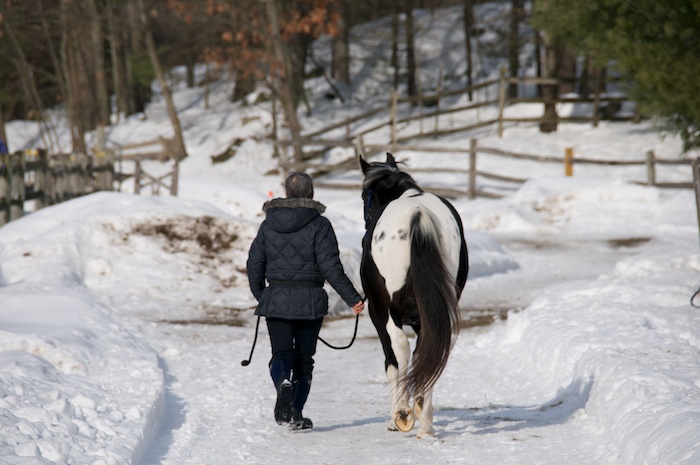
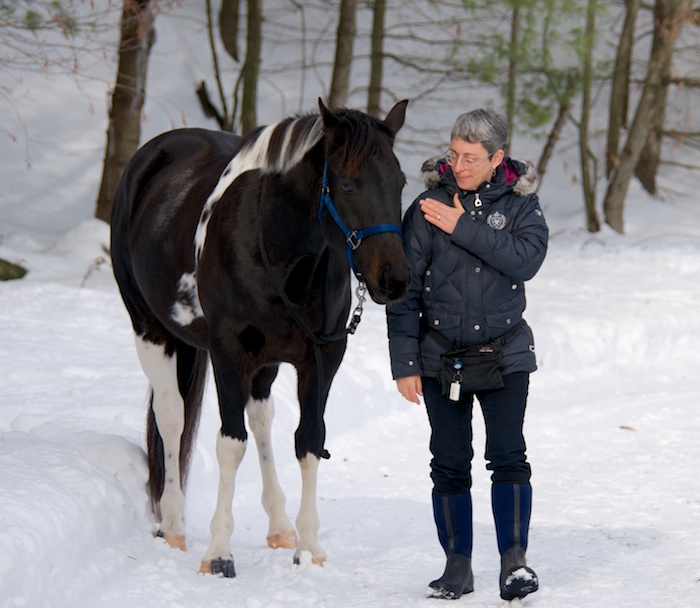
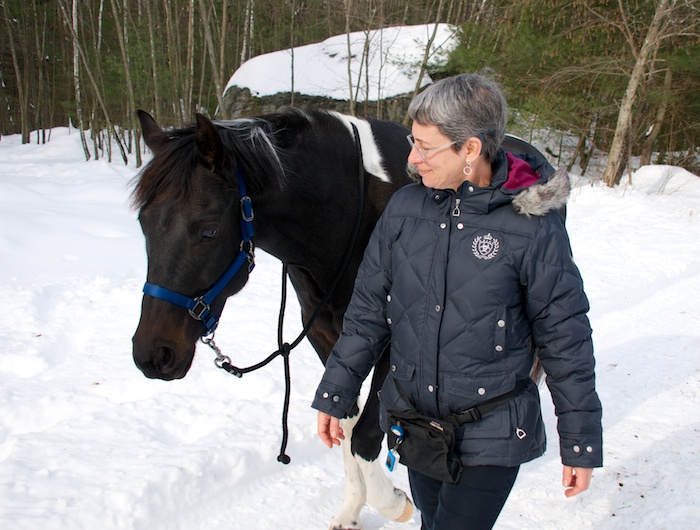
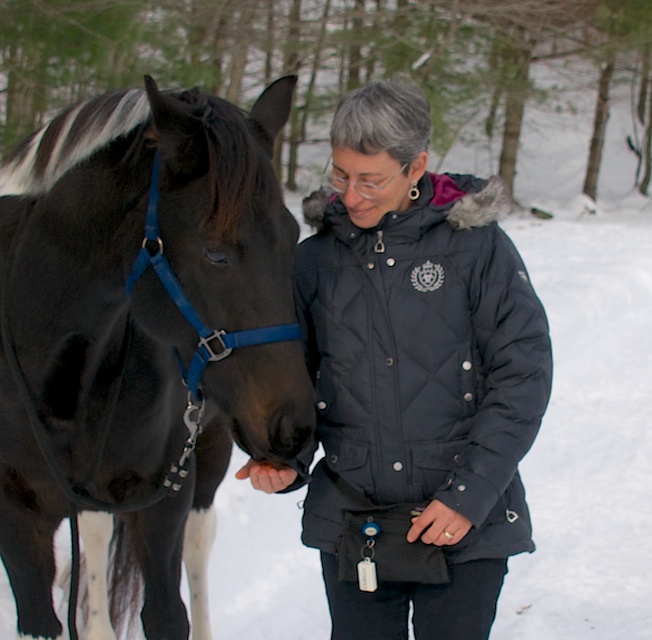
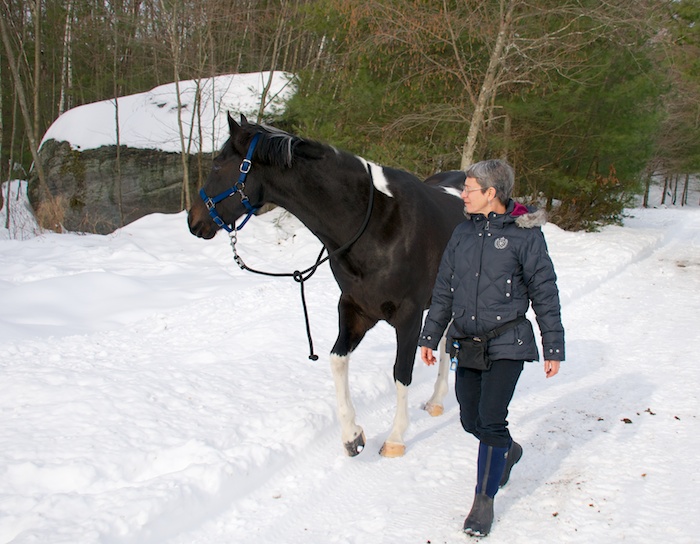
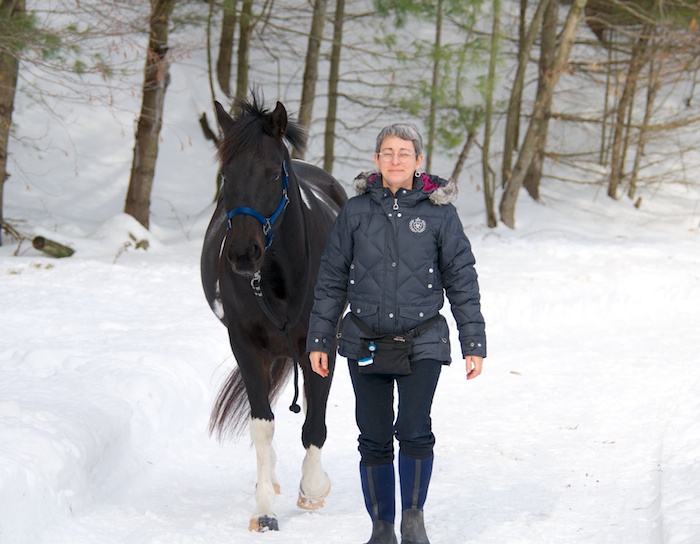


You two were just meant to be together :)
Thank you for the lesson. You do clicker training with your classroom & book model hens, but I think more people will be learning the technique from you now because of this posting involving a brilliantly beautiful horse. (I’m so happy you have him.)
Excellent, excellent post.
Click!
KP
It sounds like you know a ton about training animals. Do you have any ideas for training an adopted (rescue) dog not to bite? Would clicker training work for that, and how, since the bites are infrequent (good) and seem to come without warning (bad). :( we love this dog and would hate to give him up, but we have four children, including a baby, so he has to learn not to bite. Any ideas would be so appreciated!
Dogs very rarely bite without warning. You might be missing body language. He might be quickly reactive and it is hard to see (especially if you are distracted with children, etc.) It is possible to correct this situation, but you need professional help. (Clicker training is one way to do – never hire a trainer who resorts to aggression to cure aggression!) With 3 children and a baby, there’s a lot going on in your household. The most important thing that you have to do is to protect your children. When I first got Lily, she was so reactive that I brought in a professional trainer, who helped and also evaluated the situation for me. My children were older, and were dog savvy. I knew what to do. Still, it was a lot of work to make things safe. If I’d have had a baby at the time, I would have found Lily a new home, and I wouldn’t have felt guilty about it. Neither should you if it comes to that. I wish you the best!
He’s lucky to have you!
The photo’s are just beautiful! We got our horses as colts so we had them before riding. I guess we didn’t really train them like you are. We used only “walk, easy & whoa” including body movements and the same tone of voice with each word. Maybe because they were so young we had no problems. I did allow nuzzling in the morning but of course there was a gate between us and it meant they were ready to go to the run. I think I enjoyed it more then they did. The only aggressive animal I ever had was a lama…they have no “horse sense!”
It sounds like you were consistent, clear and kind. That’s excellent training, too.
Love the post and beautiful pictures of the both of you together!
At what point will he be expected to “heel” beside you without frequent treats? Will you need to continue treats in order to maintain the behavior?
I don’t look at it as “frequent treats.” That has negative connotations – as if I am bribing the horse and the work wouldn’t exist without it. (The alternative to rewards is doing negative punishment and removing it when the horse behaves. I’d rather do rewards than constant corrections.) Rather, the treats are part of training and communication. Once the behavior is taught, you don’t have to click for each time you get it. Eventually Tonka will walk all around the track for one carrot coin. Rewards can change. Maybe I’ll let him graze as a reward. But, every time I up the criteria, that will require a return to frequent rewards. For example, walking next to me is easy on the track. But what if we’re at the state park? The ocean? Around horses he doesn’t know? That’s another positive training opportunity. Instead of having to yank on his halter, I’ll be able to tap my shoulder and he’ll (hopefully) relax and focus on me and the safe work he’s familiar with.
This blog is so, so beautiful I had tears in my eyes. It’s amazing what you have accomplished in such short time. Have you ever trained cats?
I have not. I’m allergic to cats! But I have a friend who wrote a book about it.
http://store.clickertraining.com/cat-training-kit.html?source=featuredproducts
Thank you, Terry, I will have to look into her book.
Love this post! Are there books that you like that focus on clicker training for horses? I would like to learn this method before we look into getting a horse.
Clicker training a horse is not for everyone. Done badly (I recently saw a cringe-worthy seminar) it can lead to dangerous behavior. Horses are very fast learners, and personally, I think it’s best if you practice first on another animal. Do you have a dog? As far as books go -I’ve read some, but cannot wholeheartedly endorse any of them. To understand the concepts behind clicker training, start at the source, Karen Pryor’s book, Don’t Shoot the Dog.
What’s most important in training is the attitude. What clicker training teaches is to 1) be clear in your own mind the finished behavior you want 2) break that behavior down into very small steps 3) reward each step to build up the behavior. 4) Look for a way to focus on the good behavior, not focus on the stuff that is “bad”. Even before I learned about clicker training, I was taught when riding to “look for the good stride and more will follow.” The clicker is simply a tool that makes it all go much faster and gives you a direct line of communication.
Wonderful post and beautiful photos, thankyou xxx
Beautiful pictures! Excellent work!
Very interesting post. Beautiful photos. Beautiful budding relationship. You are very clearly in your element, Terri.
This is so impressive! Wow! Thanks for sharing all the info. and beautiful pictures!
OMG. I wish I had money for all the people I’ve dealt with who were having fits because their horse was “attacking” them. As in running at them, rearing and clopping their front legs down onto their shoulders. Why? Because when the horse was a baby they thought it was soooooo cute and picture worthy to put the baby horse’s front legs up on their kids’ shoulders. And, of course, they would be petting and feeding him the whole while. Ditto for all the ones who played “tag” with their horses when they were little and then couldn’t understand why their horses would knock them down in the field.
I was very fortunate in the first person I went to work for as a teenager. She believed in handling foals from day one, which was not popular in the 70’s. At least in the part of the country I was in. And she always said, “Think about the future. Would you want a 1,000 lb. animal behaving like this?” (A phrase I altered when working with small dog owners. Would you want a German Shepherd to do this to you?) She spent a lot of time teaching about what was “natural” for the animal and how it affects them and how you can make it work for you (something my father also taught me from day one). She encouraged you to go sit in the field and just watch “how” the horses interacted with each other. Our “clicker” was an immediate “Yes!” Unfortunately, as I went on, I found she was in the minority.
As for clicker abuse, jeez Louise, what a mess. There are way too many dog owners out there that want a “one stop shop” solution for their dogs. The clicker is supposed to solve everything. One episode I witnessed in a pet store had me laughing in frustration, if you get my meaning; it was that or scream. This woman’s dog got away from her and was tearing around barking and jumping on people. She was chasing the dog saying, “Come!” and clicking the clicker and tossing treats on the floor (which were ignored). This escalated into her shouting “Come!” and holding the clicker up in the air, pointing it at the dog like a gun, and clicking rapidly as she chased the dog around the store. Finally, someone grabbed the dog as he went by. She then began trash talking the trainer she took her dog to. And, yes, it is possible her trainer wasn’t any good with clickers. But from her behavior towards her dog, I’m more inclined to thing she’s one of the “one stop shop” people. It was awful.
Okay, I’ll quite rambling now. Misuse of training aids makes me crazy. (Don’t get me started on head halters for dogs…)
Oh dear, so much of that scene you describe with the clicker is so extremely wrong! Rant away :)
maybe the batteries had run out ;-)
Wonderful to see a trainer understand and use the principles of shaping a behaviour.
“Jackpot” to the trainer.
I would like permission to use this post in a future lesson
cheers
Heather
Hi Heather- I’m happy to have my writing shared with others. Please don’t reproduce it without emailing me and discussing that usage. (To email simply click on the “contact Terry” bar on the bottom right of this page.) A mention on a blog with a live link is always welcome! And thanks for the jackpot. It’ll be my second cup of coffee. :)
Wow. What a beautiful post… pictures and relationship alike.
Loving the Adventures of Terry & Tonka!
Gosh, he is a beautiful animal! Great post Terry.
I’ve never been much of a horse person, but I’m already loving this! Lovely photos!
So glad you found each other. Looks like a terrific partnership!
Your post has motivated me to make time to practice using the clicker properly, and then to train my dog to do just what you have accomplished with Tonka – to walk beside me off-leash. Thank you!
Nice job!
That is so rad-!!! It is one thing to ride, but to walk with one’s horse as a companion, the horse trusting the human as a fellow member of the herd. I never would have thought anybody would try such a thing. Seems like it would be especially great for horses who are “retired” from riding.
Happy New Year! :-)